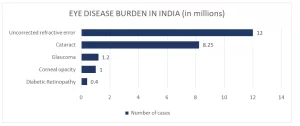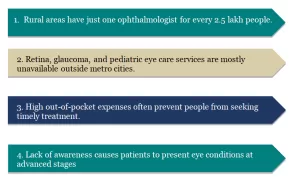INTRODUCTION
India carries one of the world’s highest burdens of visual impairment and blindness, despite many of these conditions being preventable or treatable. With a rapidly aging population, a sharp increase in diabetes, and uneven access to specialized eye care — especially in rural and Tier 2–3 cities — the demand for affordable, quality ophthalmology services is growing rapidly.
This evolving landscape presents a compelling case for private investment in eye care infrastructure, with immense potential for social impact and sustainable growth.
DEMOGRAPHIC PROFILE
| Estimated Population | 125 million |
| Blind Individuals | 12 million |
| Visually Impaired | 52 million |
| Moderate to Severe Vision Loss | 40 million |
| Uncorrected Refractive Errors | ~45–50 million |
| Children with Visual Impairment | 320,000 |
DISEASEBURDEN

HOW DOES INDIA COMPARE GLOBALLY?
| Metric | Global (2025 est.) | India (2025 est.) | India’s Share |
| Total Blind People | ~60 million | ~12 million | 20% |
| Total Visually Impaired (incl. moderate/severe) | ~295 million | ~52 million | ~17.6% |
| Uncorrected Refractive Errors | ~160 million | ~45–50 million | ~30% |
| Cataract Cases (blindness-level) | ~35 million | ~8 million | ~23% |
| Diabetic Retinopathy (vision-threatening) | ~100 million | ~10 million | 10% |
As of 2025, India ranks #1 in the world in terms of both the absolute number of blind people and the total number of visually impaired individuals.
CURRENT CHALLENGES IN OPHTHALMOLOGY CARE

💡 WHY INVEST IN EYE CARE INFRASTRUCTURE?
- High Disease Burden:
India accounts for 20% of global blindness, with over 12 million blind and 52 million visually impaired. Cataract and uncorrected refractive errors are leading causes.
- Rising Demand:
Aging population, increased screen time, and lifestyle diseases like diabetes are expected to double the patient load by 2030.
- Gaps in Access:
Rural India suffers from a severe shortage of ophthalmologists, eye surgery facilities, and retina care. Private sector participation is essential to bridge this urban-rural divide.
- Scalable Models:
Eye care, especially cataract surgeries, can follow a high-volume, low-cost model that’s financially viable and socially impactful.India’s $2.1 billion ophthalmology market is expanding rapidly, driven by demand in Tier 2–3 cities, tech-enabled care, and medical tourism. Key investment areas include day-care centres, tele-ophthalmology, AI screening, and training institutes.
GOVERNMENT INITIATIVES SUPPORTING EYE CARE
| Initiative | Features & Benefits |
| NPCBVI
(National Programme for Control of Blindness & Visual Impairment) |
Public-private partnerships, subsidized surgeries, mobile eye units |
| Ayushman Bharat – PM-JAY | Covers cataract surgeries in empaneled private hospitals |
| Digital Health Mission | Encourages teleconsultation, EMR integration, and e-health records |
IS THERE A NEED FOR EYE CARE HOSPITALS?
Absolutely – Here’s Why:

CONCLUSION
India, with the highest global burden of visual impairment, presents a unique opportunity for investment in ophthalmology. Rising demand, underserved regions, and strong policy support make eye care a high-impact, high-return sector. Strategic investments can transform millions of lives while building a sustainable and scalable healthcare model.
Sources:
https://www.who.int/publications/i/item/world-report-on-vision
https://www.researchgate.net/publication/348189782_World_Report_on_Vision
Related Team Members




















